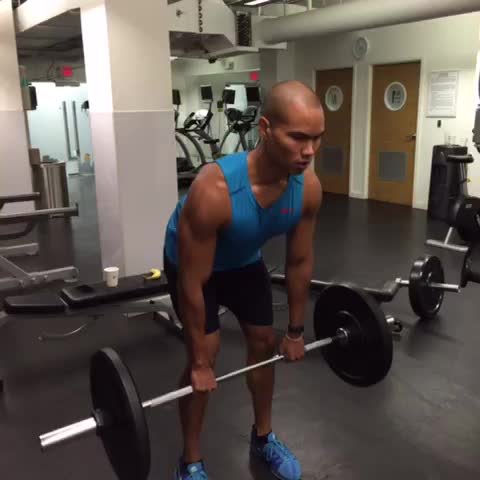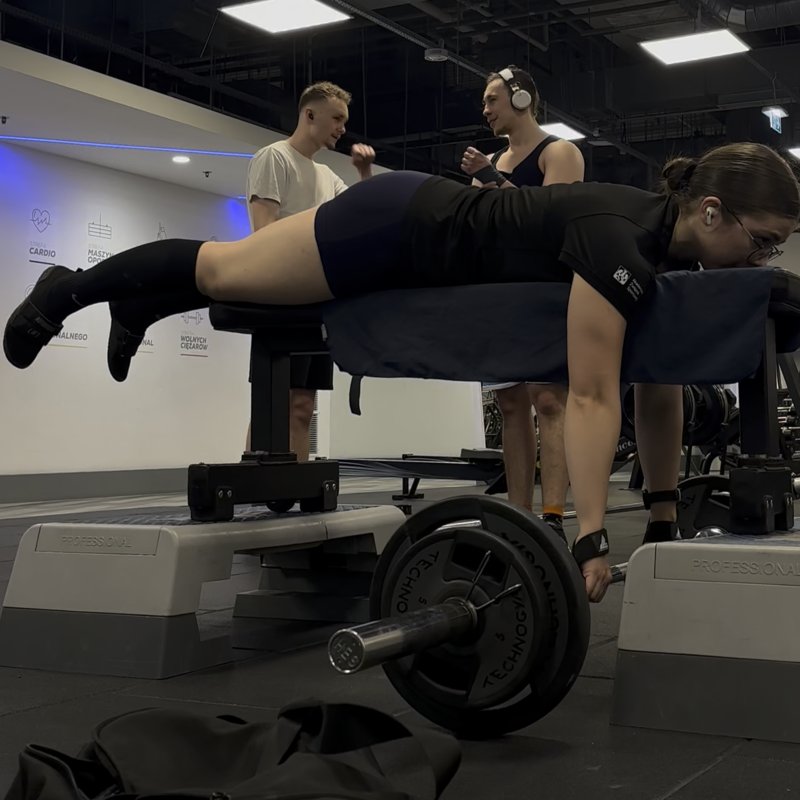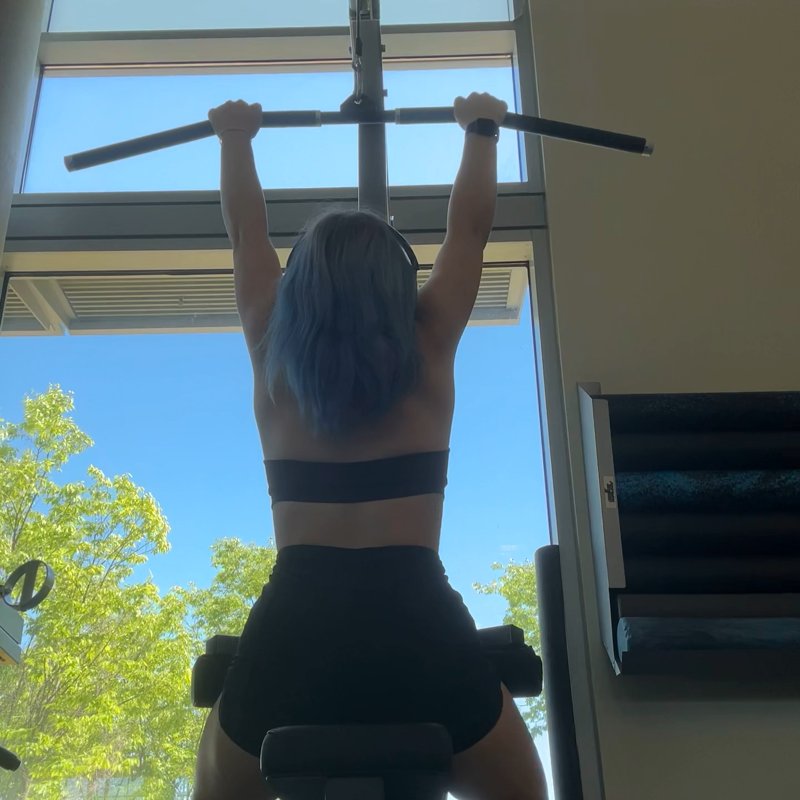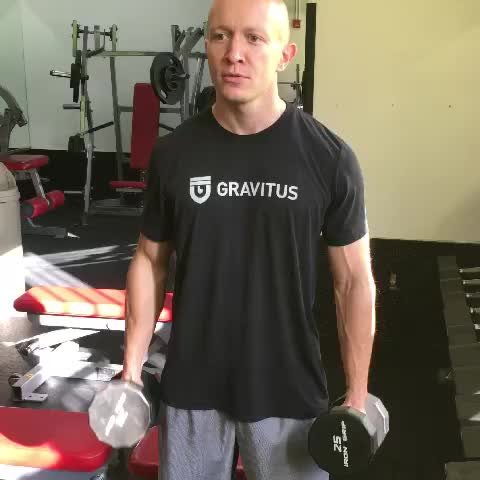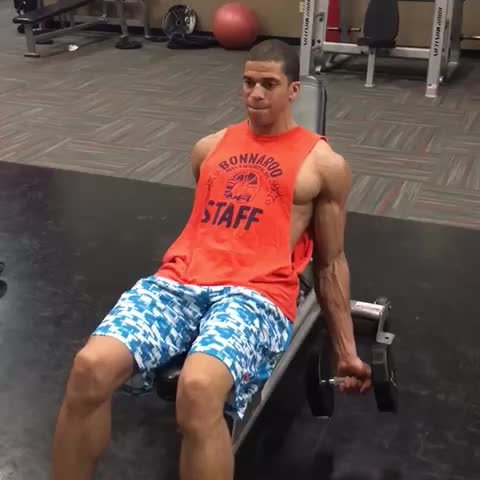One-Arm Dumbbell Row: The Ultimate Guide
The One-Arm Dumbbell Row is a unilateral back exercise that targets the latissimus dorsi, rhomboids, and rear deltoids by pulling a dumbbell from a hanging position to the side of your torso while supporting yourself with your opposite arm.
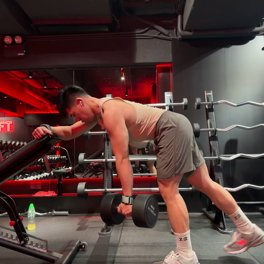
Quick Facts
Key Benefit
Balanced back development and improved core stability
Primary Muscles
Lats, Rhomboids, Traps
Secondary Muscles
Biceps, Brachialis, Erector Spinae, Obliques, Posterior Deltoids
Equipment
dumbbells, flat bench (optional)
Difficulty
Beginner
Type
Strength
In This Guide
Ready to master the One-Arm Dumbbell Row?
Track your progress, see improvements over time, and build strength consistently.
Download GravitusThe One-Arm Dumbbell Row is one of the most effective unilateral exercises for developing back strength, thickness, and muscle mass. Unlike bilateral exercises such as barbell rows or seated cable rows, this movement allows you to focus on one side of your back at a time, which offers several unique advantages for your training.
As a unilateral exercise, the One-Arm Dumbbell Row helps identify and correct strength imbalances between your left and right sides. Most people have a dominant side that naturally becomes stronger through daily activities, and this exercise allows you to address these disparities directly.
Beyond targeting the major back muscles including the latissimus dorsi, rhomboids, and trapezius, this movement also significantly engages your core stabilizers. The anti-rotation demand created by the single-arm pulling motion forces your obliques and other core muscles to work overtime to maintain proper body position.
Whether you're a beginner looking to build fundamental back strength or an advanced lifter seeking to add dimension to your physique, the One-Arm Dumbbell Row deserves a place in your training regimen. Its versatility, effectiveness, and ability to be performed with minimal equipment make it a staple in most well-designed resistance training programs.
Benefits of One-Arm Dumbbell Rows
The One-Arm Dumbbell Row offers several unique advantages that make it a valuable addition to any training program.
Muscle Imbalance Correction
Allows you to identify and address strength disparities between your left and right sides, leading to more symmetrical development.
Core Stability Development
Engages your core muscles intensely to resist rotation during the pulling motion, building functional stability that transfers to other activities.
Enhanced Mind-Muscle Connection
The unilateral nature of the exercise helps you focus on and feel the target muscles working, improving your ability to engage them effectively.
Increased Range of Motion
Compared to barbell variations, allows for greater range of motion and freer movement of the shoulder blade, potentially stimulating more muscle growth.
Accessibility and Progression
Requires minimal equipment and can be easily scaled from beginner to advanced levels by adjusting weight, position, and technique variables.
Proper Form & Technique
Setup
- Place a dumbbell on the floor beside a flat bench (or sturdy platform).
- Position yourself with your right knee and right hand on the bench, keeping your back flat and parallel to the floor.
- Plant your left foot firmly on the ground for stability, keeping a slight bend in your left knee.
- Reach down with your left hand and grasp the dumbbell with a neutral grip (palm facing your body).
- Ensure your spine is neutral (not rounded or excessively arched) and your neck is aligned with your spine.
- Brace your core to maintain this stable position throughout the exercise.
- Allow your arm to hang straight down with the dumbbell, creating a stretch in your back muscles.
Movement
- Keeping your back flat and core engaged, pull the dumbbell up toward your hip.
- Focus on initiating the movement by driving your elbow back and up, leading with your elbow rather than your hand.
- Pull until the dumbbell reaches the side of your torso, with your elbow passing your back.
- Squeeze your back muscles at the top of the movement, focusing on the contraction.
- Slowly lower the dumbbell back to the starting position with control, feeling the stretch in your back muscles.
- Complete all repetitions on one side before switching positions to work the opposite arm.
- Maintain proper breathing throughout, exhaling during the pulling phase and inhaling during the lowering phase.
Key Form Tips
Core Stability
Keep your core engaged throughout the movement to prevent unwanted rotation or sagging of the torso.
Elbow Path
Focus on driving your elbow up and back rather than just lifting the weight, ensuring back muscle engagement rather than arm dominance.
Shoulder Position
Allow your shoulder blade to move naturally through protraction (at the bottom) and retraction (at the top) for optimal muscle engagement.
Torso Position
Maintain a flat back parallel to the floor throughout the movement, avoiding the temptation to rotate or twist as you lift.
Head Alignment
Keep your neck in neutral alignment with your spine, neither looking up nor down excessively, to prevent neck strain.
Muscles Worked
Primary Muscles
- lats: The large, flat muscle covering the width of the middle and lower back, responsible for the pulling motion.
- rhomboids: The muscles between your shoulder blades that retract and rotate the scapula during the pulling motion.
- traps: The diamond-shaped muscle extending from the neck to the middle back, helping to stabilize the shoulder blade.
Secondary Muscles
- posterior deltoids: The back portion of the shoulder muscle, assisting in the pulling motion and shoulder stability.
- biceps: The front arm muscle that helps flex the elbow during the pulling movement.
- brachialis: The muscle beneath the biceps that assists with elbow flexion during the row.
- obliques: The side abdominal muscles that work to prevent rotation of the torso during the unilateral pulling motion.
- erector spinae: The group of muscles running along the spine that help maintain proper back position throughout the exercise.
Common Mistakes and How to Fix Them
Rotating the Torso
Twisting the body during the pull reduces back activation and can strain the spine. Keep your shoulders and hips squared throughout the movement, engage your core to resist rotation, and consider using a lighter weight until you can maintain proper position.
Using Momentum
Swinging the weight up with body momentum rather than controlled muscle contraction. Focus on a deliberate tempo, pausing briefly at the top of each repetition, and consider reducing the weight to maintain strict form.
Improper Back Position
Rounding the back or allowing it to sag during the exercise. Engage your core before beginning each repetition, maintain awareness of your spine position throughout, and consider setting up in front of a mirror initially to monitor your form.
Inadequate Range of Motion
Not fully extending the arm at the bottom or not pulling the dumbbell high enough. Focus on feeling a stretch in your lats at the bottom position and ensure your elbow travels past your back at the top, potentially using a lighter weight to achieve full range.
Pulling With the Arm
Using primarily the bicep rather than the back muscles to move the weight. Focus on initiating the movement by driving the elbow back rather than pulling with the hand, imagine your arm as a hook, and concentrate on squeezing your shoulder blade at the top of the movement.
One-Arm Dumbbell Row Variations
Position Variations
-

Bent-Over One-Arm Dumbbell Row
Performed without a bench, standing with feet shoulder-width apart and hinging at the hips, with one hand braced against the thigh.
-

Incline Bench One-Arm Row
Using an incline bench for support, changing the angle of pull and potentially increasing the range of motion.
-

Supported Standing One-Arm Row
Standing with one hand supported on a rack or sturdy surface while performing the row.
-

Kneeling One-Arm Row
Performed with both knees on the ground and one hand on a bench, creating a more stable base.
Technical Variations
-
Meadows Row
Performed with a landmine attachment or barbell in a corner, creating a unique angle of pull that emphasizes the lats.
-
Renegade Row
Combining a one-arm row with a plank position, significantly increasing core engagement and stability demands.
-

Dumbbell Row with Isometric Hold
Incorporating a 2-3 second pause at the top of the movement to increase time under tension and muscle activation.
-

Heavy-Light Contrast Rows
Alternating between heavy sets for strength and lighter sets with higher repetitions for endurance and metabolic stress.
Frequently Asked Questions
The appropriate weight depends on your experience level, current strength, and training goals. As a general guideline, select a weight that allows you to complete your target repetitions with proper form while still finding the last 2-3 reps challenging. For beginners, this typically means 10-15 repetitions with a weight that feels moderately difficult. Intermediate lifters might work in the 8-12 repetition range with a more challenging weight. Advanced lifters might occasionally use heavier weights for 6-8 repetitions to emphasize strength development. The key indicator is form - if you're unable to maintain a flat back, prevent rotation, or achieve a full range of motion, the weight is too heavy. For most people, the appropriate dumbbell for one-arm rows will be significantly heavier than what they use for exercises like lateral raises or bicep curls, but lighter than what they might use for exercises like dumbbell bench press or squats.
Neither exercise is inherently "better" - they each offer unique advantages and work best when used complementarily rather than exclusively. One-arm dumbbell rows excel at targeting muscle imbalances, allowing greater range of motion, enhancing mind-muscle connection, and developing rotational stability through core engagement. Barbell rows typically allow for heavier total loading, create a balanced bilateral stimulus, may be more time-efficient for some trainees, and can be excellent for developing overall back thickness and strength. Your training history, goals, and individual mechanics should determine which exercise receives priority in your program. Many successful training approaches incorporate both exercises, either within the same training session (e.g., heavy barbell rows followed by moderate-weight one-arm rows) or across different training days in a weekly cycle (e.g., barbell rows on Monday, one-arm rows on Thursday). If back development is a priority, consider including both variations in your program to benefit from their complementary effects.
Developing proper back engagement during rows requires both technique adjustments and mental focus. Start by thinking of your arm as simply a "hook" connecting your back to the weight - your biceps should assist but not drive the movement. Initiate each repetition by pulling your shoulder blade back and down (retraction and depression) before bending your elbow. Focus on leading with your elbow rather than your hand, imagining driving your elbow toward the ceiling and behind you. At the top position, consciously squeeze your shoulder blade toward your spine for 1-2 seconds to enhance the mind-muscle connection. Consider using a lighter weight temporarily to perfect the sensation of back engagement before progressing to heavier loads. Some lifters benefit from cues like "break the bar" or "crush a walnut in your armpit" to activate the lats properly. Tactile feedback can also help - having a training partner lightly touch the target muscles during the movement creates awareness, or you can reach across with your free hand between sets to feel the working muscles. If you consistently feel the exercise primarily in your arms, consider variations like chest-supported rows that minimize the biceps' contribution and force back engagement.
Both pulling positions have merit and emphasis different aspects of back development. Pulling to the hip (lower position) tends to better engage the lower lats and creates a more direct line of pull for the latissimus dorsi, making it ideal for developing back width and thickness. This position typically allows for heavier weights and often feels more natural for most lifters.
Pulling to the chest or ribcage (higher position) places greater emphasis on the upper back musculature including the rhomboids, middle/lower trapezius, and rear deltoids, making it beneficial for posture improvement and shoulder health. This position may require slightly lighter weights but can create more complete back development.
Rather than choosing exclusively between these positions, consider incorporating both into your training - either by alternating between sessions (lower pulls on Monday, higher pulls on Thursday) or by including both within the same workout (perhaps using the hip-directed pull for heavier sets and the chest-directed pull for moderate-weight, higher-repetition work). Your individual structure, goals, and what feels most effective for you should ultimately guide your choice of pulling position.
Video Demonstrations
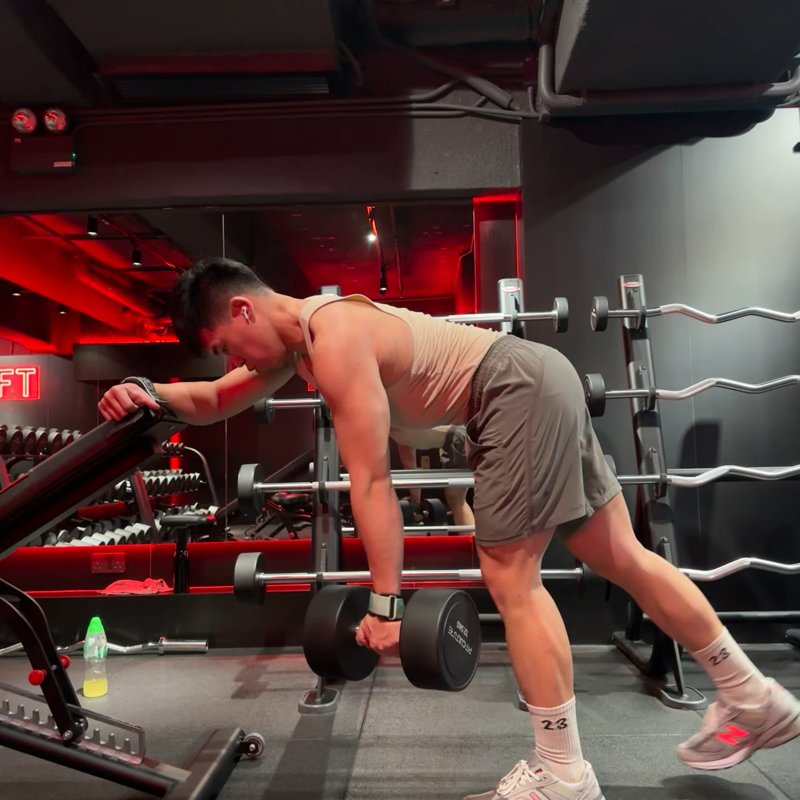
Log in to watch video demonstrations
Login to Watch3 video demonstrations available
Find more video demonstrations in the Gravitus app
Tips from the Community
-

Focus on moving your elbow back. Ignore your forearm.
-

Could be combined with a single leg deadlift or a lunge for a total-body exercise.
-

Bend over like in the pictuere, every rep should touch the flor. Tap-and go. This way you get a nice stretch at the bottom. Contract with force, control the weight down. Que: pull with you elbow.
Track your progress with Gravitus
Download Gravitus to log your workouts, track your progress, and join a community of fitness enthusiasts.

Helpful Resources
One Rep Max Calculator
Find your one rep max for any exercise without maximal testing. Essential for developing effective strength training programs.
Calculate 1RMWorkout Programs
Follow structured workout programs created by fitness professionals to maximize your strength and muscle gains.
View Programs